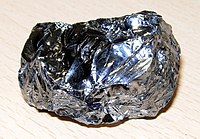
Photo from wikipedia
Abstract In this work, we have systematically explored the atomic structure, adhesion work, interfacial energy and fracture mechanism of the semi-coherent Al(1 1 1)/Al3BC(0001) interface using the first-principles calculations. The relaxed atomic… Click to show full abstract
Abstract In this work, we have systematically explored the atomic structure, adhesion work, interfacial energy and fracture mechanism of the semi-coherent Al(1 1 1)/Al3BC(0001) interface using the first-principles calculations. The relaxed atomic structure reveals that the MT configurations are unstable and moves to HCP1 and HCP2 configurations. Furthermore, the obtained adhesion works and interfacial energies relaxed that the B-terminated Al(1 1 1)/Al3BC(0001) interface of HCP2 configurations has the highest adhesion work and the lowest interfacial energy, indicating that the HCP2-B interface is the most stable. The electronic structure of the B-terminated Al(1 1 1)/Al3BC(0001) interface shows that there are Al-B covalent bonds formed at the interface. For the B-HCP2 interface, due to the formation of strong Al-B covalent bonds at the interface, mechanical failure eventually occurs in the Al slab.
Journal Title: Applied Surface Science
Year Published: 2021
Link to full text (if available)
Share on Social Media: Sign Up to like & get
recommendations!